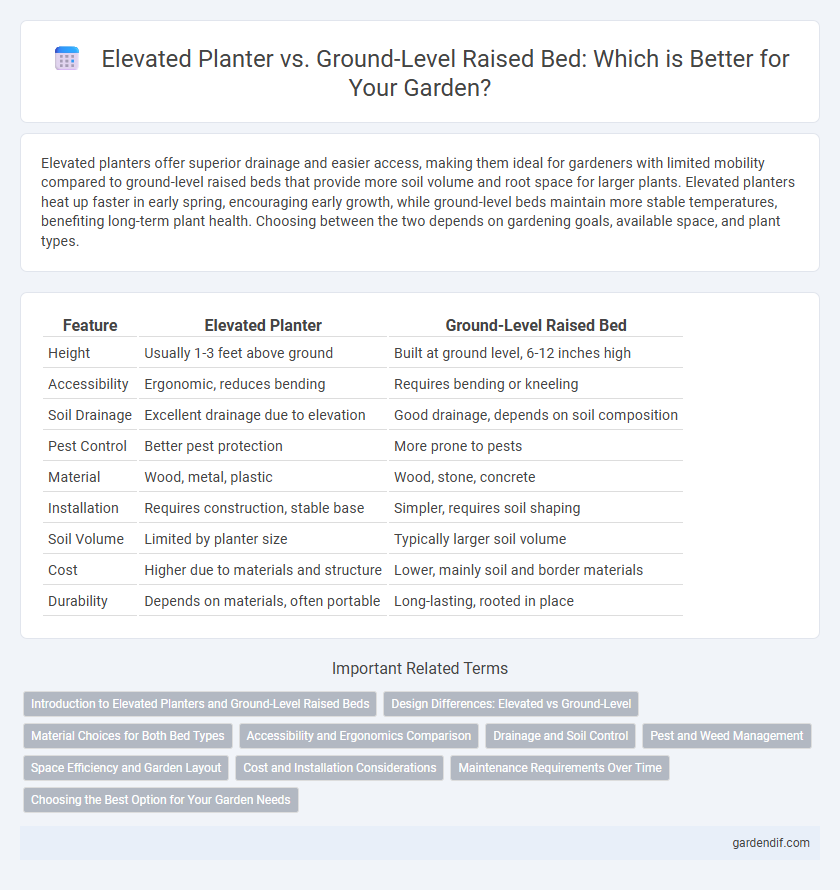
Elevated Planter vs Ground-Level Raised Bed Illustration
Elevated planters offer superior drainage and easier access, making them ideal for gardeners with limited mobility compared to ground-level raised beds that provide more soil volume and root space for larger plants. Elevated planters heat up faster in early spring, encouraging early growth, while ground-level beds maintain more stable temperatures, benefiting long-term plant health. Choosing between the two depends on gardening goals, available space, and plant types.
Table of Comparison
| Feature | Elevated Planter | Ground-Level Raised Bed |
|---|---|---|
| Height | Usually 1-3 feet above ground | Built at ground level, 6-12 inches high |
| Accessibility | Ergonomic, reduces bending | Requires bending or kneeling |
| Soil Drainage | Excellent drainage due to elevation | Good drainage, depends on soil composition |
| Pest Control | Better pest protection | More prone to pests |
| Material | Wood, metal, plastic | Wood, stone, concrete |
| Installation | Requires construction, stable base | Simpler, requires soil shaping |
| Soil Volume | Limited by planter size | Typically larger soil volume |
| Cost | Higher due to materials and structure | Lower, mainly soil and border materials |
| Durability | Depends on materials, often portable | Long-lasting, rooted in place |
Introduction to Elevated Planters and Ground-Level Raised Beds
Elevated planters are structures designed to raise soil above ground level, improving drainage and reducing strain on gardeners by minimizing bending. Ground-level raised beds consist of soil mounded within framed enclosures directly on the earth, promoting natural soil ecosystems and easier access to native nutrients. Both options enhance garden space efficiency but differ in construction, maintenance, and soil management requirements.
Design Differences: Elevated vs Ground-Level
Elevated planters feature a raised structure with legs or stands, allowing for improved drainage and easier access while minimizing soil compaction and pest intrusion. Ground-level raised beds are built directly on the soil surface, often framed with wood or stone, providing better insulation and natural soil organism interaction. Design differences emphasize accessibility, soil control, and environmental exposure, with elevated planters suited for ergonomic gardening and ground-level beds favoring traditional cultivation methods.
Material Choices for Both Bed Types
Elevated planters often use durable materials like cedar, redwood, or metal that resist weathering and provide excellent drainage, enhancing plant health. Ground-level raised beds typically favor untreated wood, composite materials, or concrete blocks, which offer strong structural support and retain soil moisture effectively. Selecting rot-resistant wood or corrosion-resistant metals ensures longevity and reduced maintenance for both elevated and ground-level raised bed types.
Accessibility and Ergonomics Comparison
Elevated planters offer superior accessibility by minimizing the need to bend or kneel, making gardening more comfortable for individuals with mobility challenges or back pain. Ground-level raised beds require more physical effort to reach plants, which can strain joints and limit ergonomic benefits. Choosing elevated planters enhances ease of use, reduces fatigue, and supports inclusive gardening practices.
Drainage and Soil Control
Elevated planters offer superior drainage due to their height and often built-in drainage holes, preventing waterlogging and root rot more effectively than ground-level raised beds. Soil control is enhanced in elevated planters as gardeners can customize soil composition precisely, avoiding issues with native soil contamination or pests common in ground-level setups. Conversely, ground-level raised beds may retain more moisture but require careful soil management to prevent compaction and drainage problems.
Pest and Weed Management
Elevated planters reduce pest problems by creating a physical barrier that limits ground-dwelling insects and rodents, while also improving drainage to prevent soil-borne diseases. Ground-level raised beds require more frequent monitoring and manual removal of weeds and pests, as they are more accessible to insects and weeds from surrounding soil. Both systems benefit from organic mulch and companion planting to enhance pest and weed management naturally.
Space Efficiency and Garden Layout
Elevated planters maximize space efficiency by allowing vertical gardening, making them ideal for small patios or urban settings where ground space is limited. Ground-level raised beds offer more extensive planting areas and easier access to soil, suitable for larger garden layouts with ample horizontal space. Choosing between the two depends on available space and desired garden design, with elevated planters supporting intensive, compact growing and ground-level beds enabling broader crop diversity.
Cost and Installation Considerations
Elevated planters generally have higher upfront costs due to materials like wood, metal, or composite, and often require more complex installation involving raised supports or built-in irrigation. Ground-level raised beds tend to be more affordable, utilizing simple lumber or stone and can be installed with minimal tools and labor, making them ideal for budget-conscious gardeners. Installation time for elevated planters is longer, but they offer improved drainage and accessibility, while ground-level beds are quicker to set up but potentially more susceptible to pests and soil compaction.
Maintenance Requirements Over Time
Elevated planters demand less frequent weeding and soil replacement due to optimized drainage and reduced pest access, leading to lower long-term maintenance. Ground-level raised beds require more consistent soil amendment and weed control because they are directly exposed to ground-borne weeds and pests. Over time, elevated planters typically sustain better structural integrity, reducing repair needs compared to ground-level beds that can degrade or erode.
Choosing the Best Option for Your Garden Needs
Elevated planters provide superior drainage, improved soil control, and easier access, making them ideal for gardeners with limited mobility or poor soil conditions. Ground-level raised beds offer greater planting depth and natural insulation benefits, which support root growth and moisture retention for larger or deep-rooted crops. Selecting the optimal option depends on your garden's space, soil quality, and the specific plants you intend to grow.
Elevated Planter vs Ground-Level Raised Bed Infographic

 gardendif.com
gardendif.com